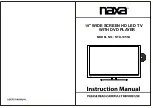
EN
14
Connections to other equipment
To connect a HDMI or a DVI device to the unit
The HDMI input receives digital audio and uncompressed video from a HDMI device or uncompressed digital
video from a DVI device.
When you connect to a DVI device with a HDMI-to-DVI adapter cable, it transfers only video signal. Separate
analog audio cords required.
NOTE:
When using HDMI1/DVI IN to connect your HDMI or DVI devices, you must select the corresponding
audio input source (HDMI or DVI) on the menu screen (see page 17). Otherwise you will only see the
image with no sound.
•
HDMI - to - DVI adapter cable
(HDMI type A connector)
(not supplied)
Audio cord (not supplied)
HDMI cable (type A connector)
(not supplied)
To DVI output
To HDMI output
HDMI device
DVI device
To HDMI IN
To PC/DVI AUDIO IN
or
Rear and Right of the unit
The audio output from the devices connected by HDMI may not output the sound from the audio output jacks
of this unit for copyright protection.
In details, please check the table below.
•
Audio Out
Content
Digital
Analog
SACD/DVD-Audio
Prohibited
Available*
Others
Available*
Prohibited
* Depening on devices, the sound may not be output.
To connect an audio system
This connection allows you to use an audio amplifier and external speakers, and adjust the audio level using the
TV’s remote control.
To control the audio, turn on the TV and the stereo amplifier, and turn off the TV’s built-in speakers (see page 17).
NOTE:
To hear sound when using an external audio amplifier, the volume of both the TV and the amplifier must be set
above 0 (zero).
For example, if the volume of the TV is set to 0, you will not be able to hear any sound, even if the volume of the
amplifier is at its highest level.
•
•
To Audio (L) Input
To Audio (R) Input
Audio cord (not supplied)
Amplifier
Rear of the unit
To VAR. (VARIABLE)
AUDIO (L/R) OUT
J3PC0321A_EN.indd 14
J3PC0321A_EN.indd 14
8/21/12 10:40:44 AM
8/21/12 10:40:44 AM















































